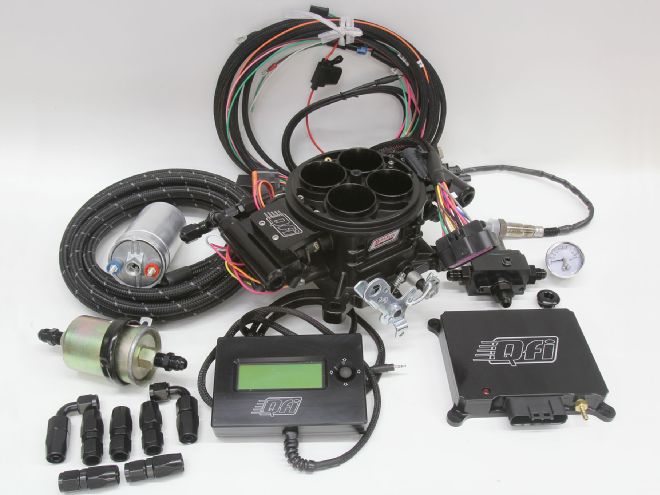
There are advantages to showing up fashionably late to the party. In this case, the party has been the slew of self-learning, throttle body (TB) EFI kits. Among the early contenders was the Powerjection system by Professional Products, then the debut of FAST's EZ-EFI 1.0 and later 2.0, followed in no particular order by MSD's Atomic system, Edelbrock's E-Street, and Holley's Terminator version. All of these kits, including Quick Fuel's Qfi, are throttle bodies with integrated fuel injectors. This makes the installation easy since all you have to do for that part of the swap is replace the carb with the throttle body.
Quick Fuel's advantage to arriving later to the party is that the company has the advantage of improving upon the competition's perceived weaknesses. So it should come as no surprise that Qfi should show up with a few additional tweaks. This is not a revolutionary system. It does the same job as the others—but perhaps just a little bit better. The Black Diamond system we tested retains the typical four, 66 lb/hr fuel injectors integrated into the throttle body and works best on engines making less than 500 hp. Unlike other systems, Quick Fuel designed its throttle body to work more like an electronic carburetor. So much so that it emulates the fuel path into the engine through a dedicated idle circuit below the throttle plates and pushes the main circuit fuel through annular discharge sleeves in the venturis. This places no obstructions in the throttle body to reduce airflow. Quick Fuel contends that these changes make their system much quicker off idle and perhaps with a bit better fuel mixing compared to other systems. That part is difficult to evaluate objectively but our testdrives did reveal what felt like a little better throttle response than previous TB systems we have driven.
We decided to bolt one of these systems on an early El Camino cruiser and run it through its paces. It's also at this point we should emphasize that perhaps the most critical thing you must do to ensure any EFI system's peak efficiency is a quality fuel delivery system. When converting an older street rod or any pre-EFI vehicle, the fuel tanks are not compatible with fuel injection. You must invest in a fuel delivery system that includes an in-tank fuel pump and some kind of reservoir system. Locating the pump inside the tank not only enhances pump cooling and extends its life but is also quieter and allows the pump to operate at peak efficiency.
Most TB EFI systems are offered in two forms either as a complete kit with a fuel pump, filter, lines, and fittings, or as a base kit without the fuel delivery components. The Quick Fuel Qfi system is no exception. We recommend purchasing the base kit and either install one of the many dedicated fuel tanks such as those from Rock Valley, Rick's Tanks, Tank's Inc., or one of Aeromotive's Phantom universal systems. The Phantom system is an ingenious universal in-tank fuel pump system that creates its own internal reservoir that eliminates the fuel slosh in non-EFI tanks.
There are advantages and disadvantages to not investing in an in-tank fuel pump system. If you go the cheap route by installing a fuel pump outside the tank, using the original fuel tank pickup will work but only if the fuel level remains above half full. Once the fuel drops below this level, fuel slosh in the tank will uncover the pickup, resulting in an immediate loss of fuel pressure. In a carbureted application this is not a problem because the float accommodates this temporary dip in pressure. But there is no accumulator in an EFI application, which means the pressure drops as soon as the pickup is uncovered—creating a noticeably and annoying sag in performance. Imagine accelerating hard across an intersection to miss a speeding cement truck only to have the engine stall because the fuel pressure drops. That's not the time to realize you should not have cheaped out on the fuel pump installation.
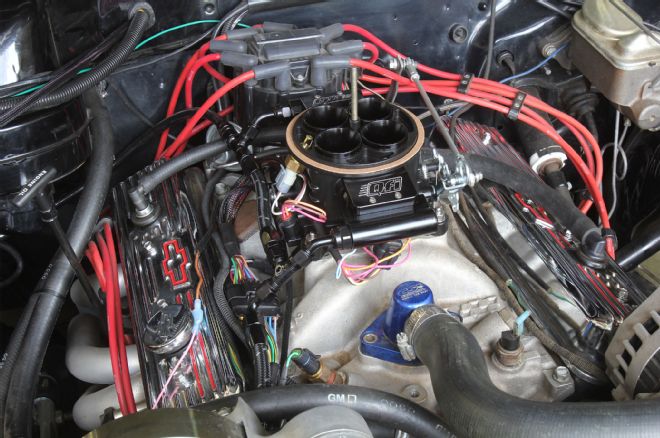
Quick Fuel's new Qfi system is the latest self-learning throttle body system to enter the performance EFI market. This is the Black Diamond version with the black powdercoated throttle body. The standard throttle body comes with a polished aluminum finish.
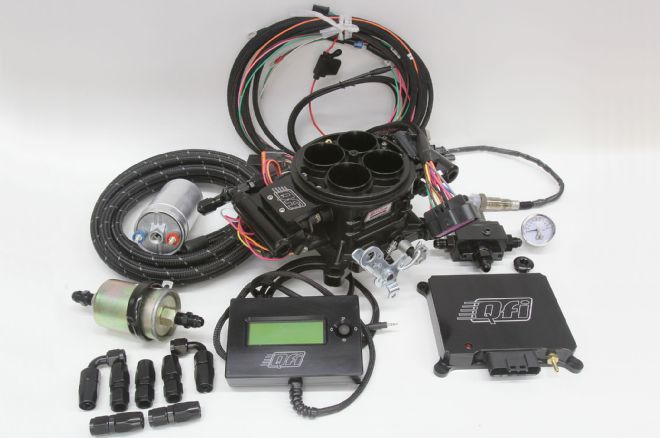
The complete Black Diamond Qfi kit comes with the throttle body, ECU, handheld tuner, wiring harness, all the necessary sensors, and also an external, high-pressure fuel pump, filter, fittings, and black braided steel fuel line. The standard kit is less expensive and excludes all the fuel delivery components.
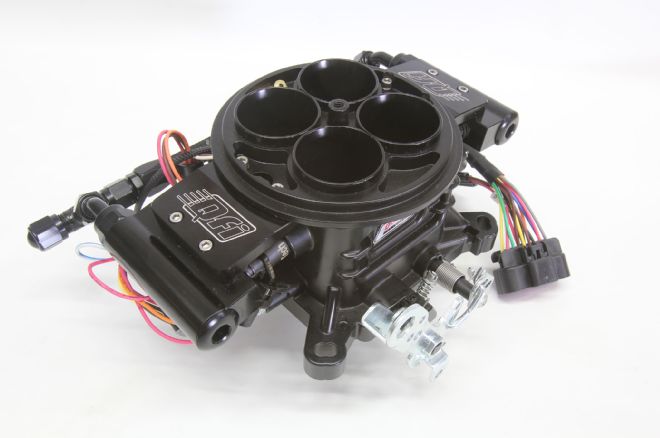
The standard throttle body is rated at 950 cfm with four 66 lb/hr injectors that at 45 psi will feed up to 525 hp. Quick Fuel has integrated all but one of the sensors into either the throttle body or the ECU. This makes installation much easier. The only additional sensors are the coolant temperature sensor (CTS) and the wide-band oxygen sensor.
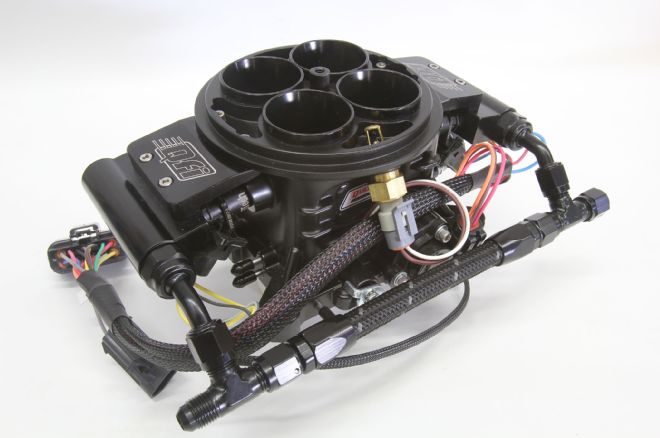
On the passenger side of the throttle body you can see the injectors located front and rear, the simple dual inlet fuel log, and the integrated air temperature sensor. There are also several taps for both manifold and ported vacuum for the MAP sensor, and for vacuum advance. There's also a large port available for either PCV or power brakes.
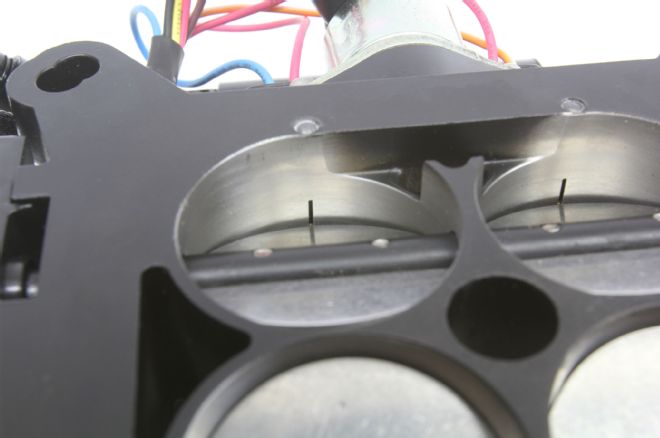
Few may notice, but Quick Fuel is the only throttle body system that delivers idle and off-idle fuel underneath the throttle plates like a carburetor. Plus, main fuel delivery from the injectors is introduced through annular discharge venturis, which places no obstructions in the inlet path.
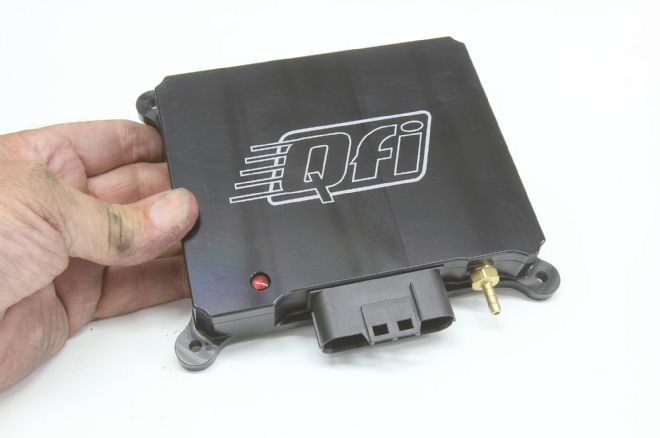
The Quick Fuel computer or ECU can be located either in the engine compartment or in the interior. We found the main wiring harness a bit short, which limited our freedom to place the ECU. The vacuum fitting is the MAP sensor connection for manifold vacuum.
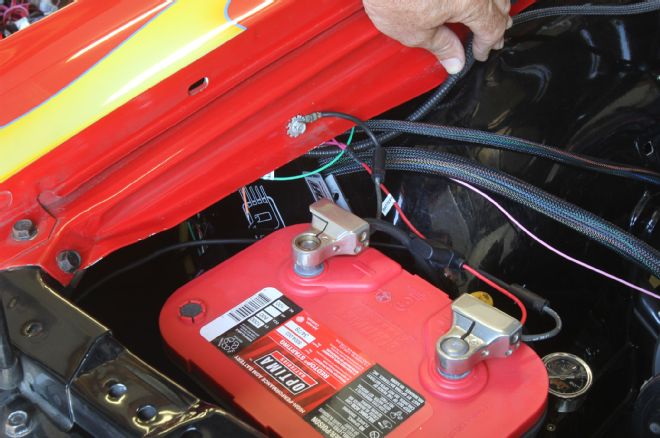
We located our ECU under the front passenger side fender near the battery to keep the main power feed wire short. In retrospect, it may have been better to place the ECU in the interior.
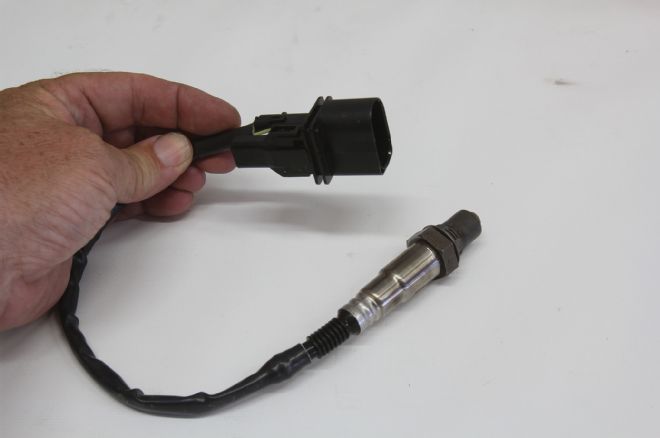
With our ECU near the front of the car, we discovered we barely had enough room to connect the oxygen sensor to the main wiring harness. Relocating the ECU to the interior would have created more wiring length. You cannot lengthen or modify the oxygen sensor harness or wires.
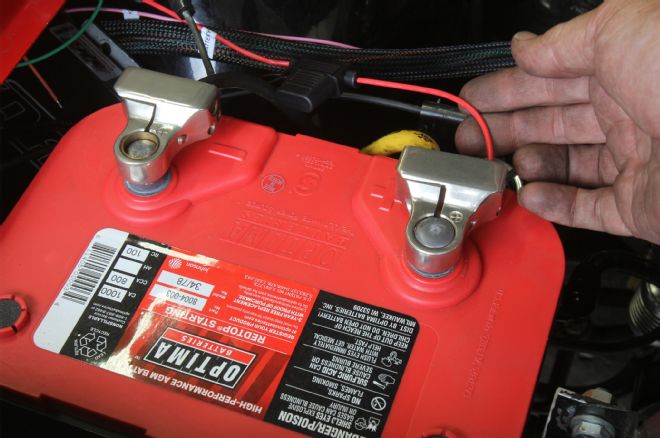
Always connect the main power feed (battery positive) and ground (battery negative) directly to the battery. This uses the battery as a capacitor, which absorbs electrical noise and makes for a happier ECU.
One of the Qfi system's additions is that it can also digitally control the ignition curve as well as the fuel. Here is where we noticed a slight miscue in the instruction manual since it does not clearly state that using the Qfi's ignition control requires that the distributor be locked out. This means that the distributor must be prevented from producing an advance curve. The easiest way to do this is with any MSD distributor. All MSD distributors are fitted with a hole in the distributor that will lock out the advance curve. But this also requires the distributor must be disassembled in order to reposition the advance pin into the lockup position. That can be done easily with the MSD GM distributors, but the Ford MSD units require a press to properly remove and install the gear. We chose to just test the fuel control portion of the Qfi system for this test. Be aware that converting to electronic ignition control does require the use of a laptop. Qfi includes the software with all kits so this isn't a problem. We would recommend waiting until you have the engine fuel properly tuned before converting to ignition control. This will reduce the number of variables during the conversion. Because we had previously outfitted our test car with an Aeromotive Phantom fuel system and had tested a competitor's throttle body system, bolting on the Qfi system was relatively painless, requiring about three hours' work at a steady pace. Once the system was fired up and running, the only physical change we had to make was to back off the idle speed setting slightly to allow the engine to achieve our desired 900-rpm idle speed.
Our test engine may be a worst-case scenario for these self-learning systems mainly because our 350 Chevy H.O. crate engine was upgraded with a COMP Cams Mutha' Thumpr camshaft. The Thumpr cams are famous for their lumpy idle, but this also creates off-idle driveability issues for any induction systems, either a carburetor or fuel injection. The Mutha' Thumpr cam specs are 235/249 at 0.050 with 0.489/0.476-inch lift and a much tighter 107 degree lobe separation angle (LSA). This combination of long exhaust duration and a closer LSA increases the overlap—the time when both the intake and exhaust valves are both open. Combined with a relatively low 8.5:1 compression ratio means that the engine needs a lot more fuel at lower speeds to compensate for all the residual exhaust that's present in the intake manifold at lower speeds.
Overall, the Qfi system offers more opportunity to fine-tune than other systems, which if you have the skill to take advantage of these offerings, can improve the overall performance. For example, Qfi offers the ability to tune the amount of fuel delivered during cold start and cold engine operation, a feature that several of its competitors do not. In the past, our one complaint with earlier competitive systems was that our engine always ran in cold operation at very rich mixtures, which tends to act like a solvent, washing the oil off the cylinder walls. The Qfi system gives you the ability to fine-tune the cold start and warmup fuel. This makes the Qfi immediately attractive.
With only about 45 minutes part-time driving with the Qfi sysem, we are still doing some minor tuning tweaks and we have yet to eliminate a slight hesitation just off idle. These issues are probably attributed to the Mutha' Thumpr cam so that with a milder cam the driveability would be good. We have noticed that this system does seem to offer a very crisp response to throttle, which may be due to the booster style of fuel delivery like a carburetor. But this is just a subjective evaluation. The system installed easily and started immediately once the system was configured. Overall, Quick Fuel has a nice self-learning system that has some features that we really like.
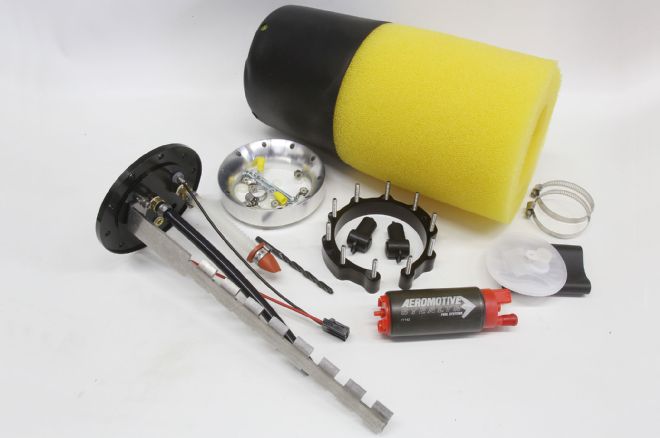
For our fuel delivery system, we used Aeromotive's Phantom system installed in a standard El Camino fuel tank. The Phantom system uses an Aeromotive Stealth 340 liter per hour (lph) pump that has a capacity to feed over 800 hp. There is a 200 lph kit that is slightly less expensive that will feed up to 550 hp at 45 psi.
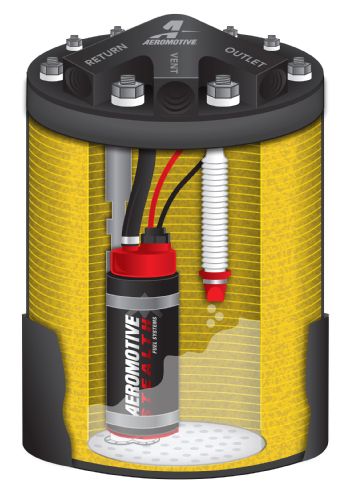
This Aeromotive illustration shows how the Phantom system works. The black plastic base creates a reservoir that is contained by the yellow fuel cell foam. Fuel is allowed to fill this reservoir and then all fuel returned from the throttle body is also delivered to the reservoir to always submerge the pump in fuel.
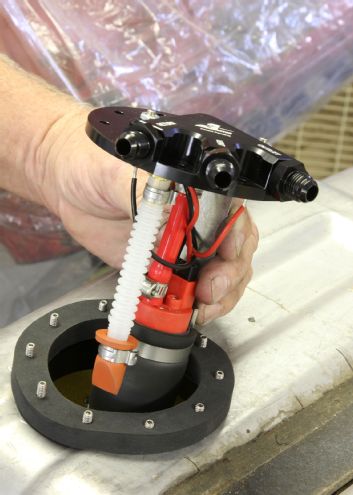
The only real fabrication work necessary is cutting a 3-1/4-inch hole in the tank. It's recommended that you do this on a brand-new fuel tank that has never contained fuel to prevent a spark igniting the fumes. That would be bad …
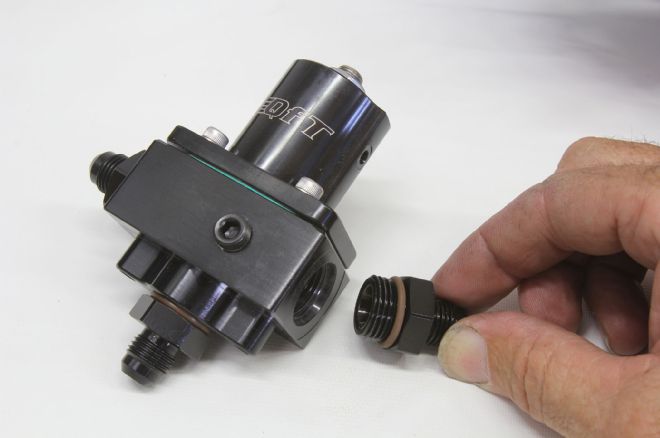
The Quick Fuel pressure regulator is supplied with all the fittings necessary for plumbing. Note that these are ORB (O-ring boss) fittings that seal using an O-ring. We mounted the regulator near the rear of the engine compartment using new fuel line. This feeds fuel from the pump to the Qfi throttle body and then to the regulator before returning to the tank.
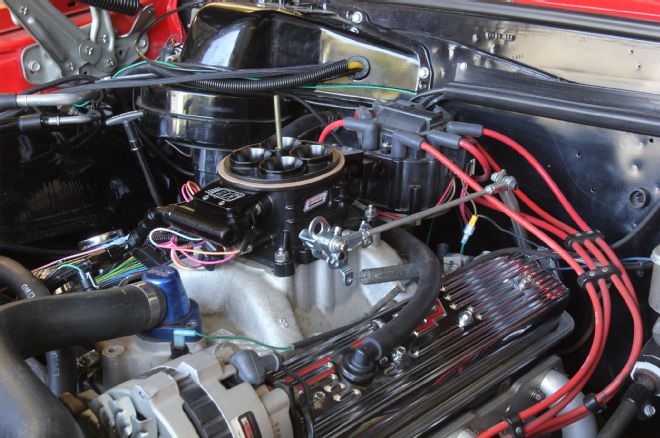
We threaded an aluminum 1/4-inch rod to connect to a pair of hardware store 1/4-inch spherical bearings that works great for throttle linkage.
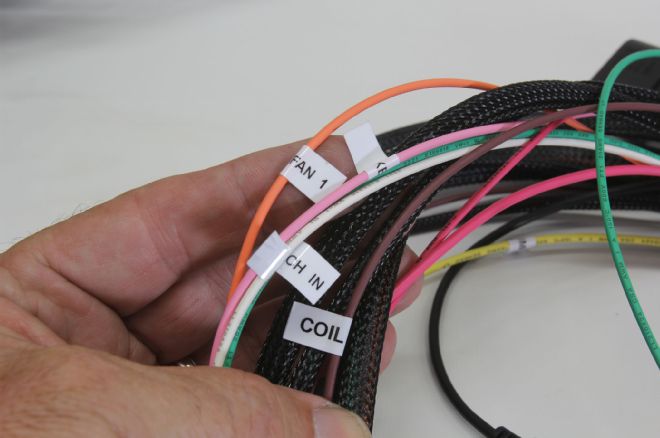
Each electrical connection is clearly marked. In addition to fuel and spark control, the Qfi will also control up to two electric fans although you will need to supply the relays. The Qfi controller also has separate on and off temperature triggers for each fan.
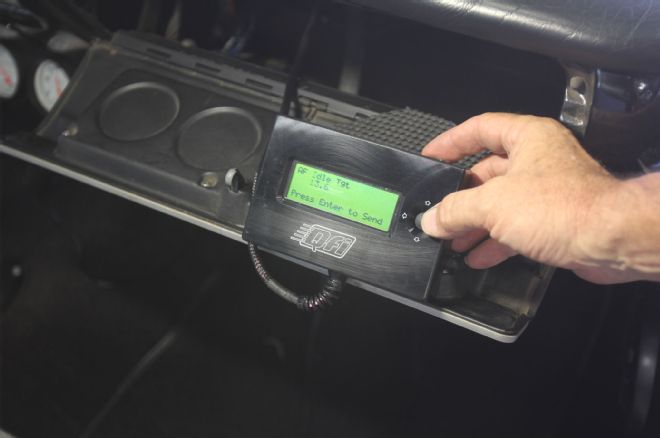
The handheld controller allows you to do virtually 90 percent of the tuning although more sophisticated inputs can be produced with a laptop. Here, we are modifying the idle air-fuel ratio target information as 13.6:1.
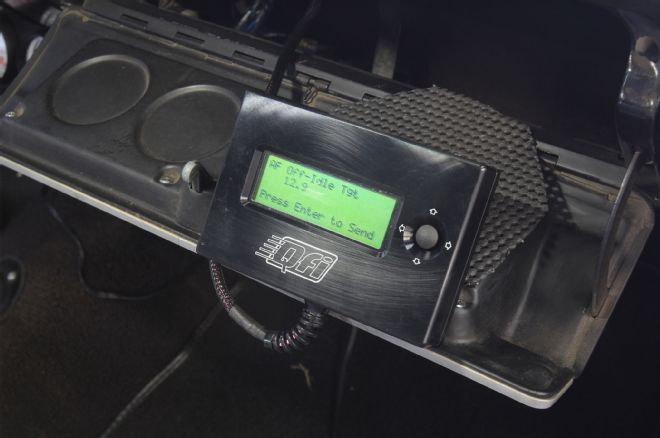
With the Mutha' Thumpr cam in our engine, we richened the off-idle fuel to 12.6:1 to help the transition when we let out the clutch. Our test car uses a four-speed with 3.08:1 gears, which loads the engine even more when starting out.
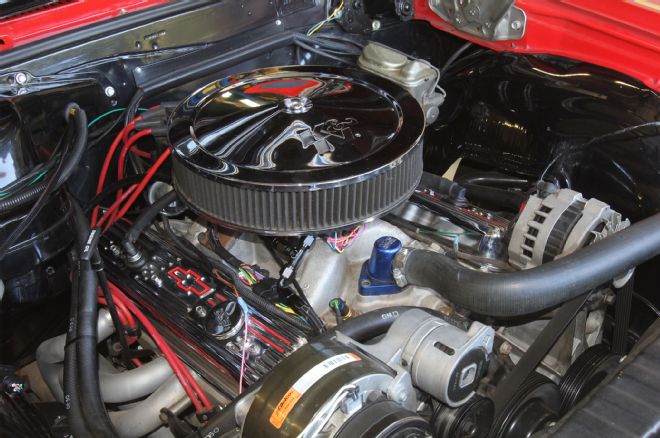
With the entire Qfi system in place under the air cleaner, only the additional wiring gives us away that this is more than a carburetor.